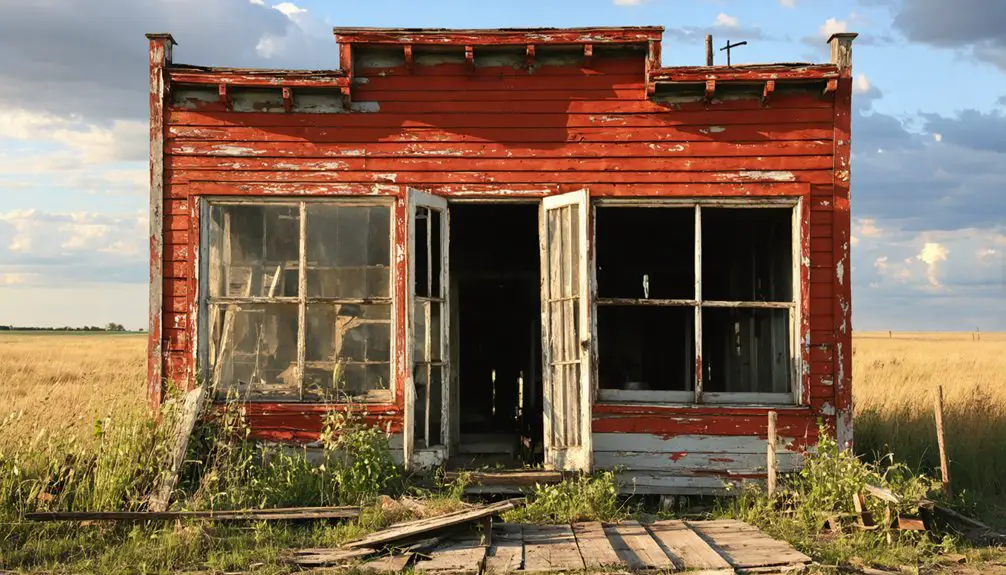You’ll find Philbrook’s remnants in central Minnesota, where only foundations and a cemetery remain of this once-bustling railroad town. Founded as Riverside in 1859 and renamed in 1890, it flourished as a hub for timber and agriculture, complete with a Catholic church, post office, and Heinz pickle factory. The Northern Pacific Railway’s abandonment and agricultural mechanization led to its decline, though local historians preserve its story through artifacts and oral histories.
Key Takeaways
- Originally named Riverside in 1859, Philbrook was renamed in 1890 and thrived as a rural hub for agriculture and logging operations.
- The Northern Pacific Railway established Philbrook as a strategic transportation center, featuring a depot, stores, and grain elevators.
- Saint James Catholic Church, post office, and railway station served as vital community centers during the town’s peak period.
- Economic decline occurred through resource depletion, agricultural mechanization, and railroad abandonment, leading to population loss.
- Today, Philbrook exists as a ghost town with only foundations and a cemetery remaining, while preservation efforts maintain its historical legacy.
The Rise and Transformation of Riverside
While many Minnesota settlements took their names from natural features, Riverside’s 1859 founding reflected its practical location near a watercourse.
You’ll find this original name didn’t stick around long though – when it came time to establish a post office in 1889, they discovered another Minnesota town had already claimed “Riverside.”
The settlement’s identity shifted in 1890 when postal authorities officially renamed it Philbrook, part of a broader effort to eliminate duplicate place names across the state. Like many early settlers with British surnames, the Philbrook family had migrated to the region seeking new opportunities.
Throughout this change, you could still find the community’s heart beating at Saint James Catholic Church, which kept serving local residents regardless of what name was on the map.
The name change marked a pivotal moment in the settlement’s evolution from its riverside origins to its new Philbrook identity. The Philbrook family later established a grocery store in 1920, becoming an essential hub for local residents.
Railroad’s Influence on Early Development
How did a simple rail line transform Philbrook’s destiny? When railroad planners chose Philbrook’s location along their expanding route through Morrison County, they weren’t just laying tracks – they were laying the foundation for an entire community.
You’ll find that rail expansion directly shaped settlement patterns, as immigrants and settlers flocked to where the trains stopped. The depot became Philbrook’s beating heart, attracting general stores, grain elevators, and hotels within walking distance. The town’s commerce expanded when the Heinz pickle factory established operations, drawing additional business to the area.
Local farmers gained a crucial connection to broader markets, while timber operations set up nearby to capitalize on rail shipping. The railroad’s influence went beyond mere transportation – it determined where people lived, worked, and built their dreams. Thanks to James J. Hill’s experimental farms and credit facilities, local farmers gained access to improved farming methods and financial support.
Rail lines transformed rural communities by connecting local enterprise to the wider world, shaping both commerce and community development.
For Philbrook, the rail line wasn’t just a path through town; it was the reason for the town’s existence.
Historical Buildings and Community Life
You’ll find traces of Philbrook’s past in three significant structures that shaped daily life: the post office that connected residents to the outside world, Saint James Catholic Church where the faithful gathered, and the railway station that served as the town’s lifeline.
Like many ghost towns in Minnesota that showcase cultural artifacts, visitors can still find remnants of everyday items from former residents scattered throughout these historic buildings.
The post office operations began in the late 19th century, while Saint James Catholic Church provided both spiritual guidance and a community gathering space for local families.
The railway station’s distinctive architecture, with its broad overhanging eaves and freight platform, reflected the standardized designs used by railroad companies throughout rural Minnesota.
Similar to the case of Forestville, the arrival of rural postal delivery ultimately contributed to Philbrook’s decline as residents gradually moved away.
Post Office Operations History
Since its establishment, Philbrook’s post office served as an essential community hub, operating from a multi-functional building that typified the modest architecture of small Minnesota towns.
Similar to the ghost river towns that vanished in the late 1800s, many post office buildings adapted to serve multiple community functions to stay viable.
You’d find postal service operations often sharing space with local businesses, creating a vibrant center for both commerce and social interaction.
Like many rural Minnesota communities in the late 1800s, Philbrook’s post office was vital for maintaining community connectivity, handling everything from personal letters to business correspondence.
Drawing parallels to Maine Prairie Corners, which had a post office serving its residents, these facilities were crucial meeting places for frontier settlements.
The mail routes connected residents to the wider world through stagecoach and horseback delivery, though service might only come weekly.
Mail carriers became notable local figures, often combining their postal duties with other community roles.
When transportation patterns shifted and Rural Free Delivery emerged in the early 1900s, it began affecting small-town post offices, signaling changes ahead for communities like Philbrook.
Saint James Catholic Church
In late 1891, Saint James Catholic Church took root in Philbrook after Daniel and Patrick Moore generously donated 10 acres of land – half for the church building and half for a cemetery.
You’d have found a modest church architecture typical of rural Minnesota, measuring just 26 x 36 feet, with construction costs of $300 for labor. The church became central to community identity, offering regular Mass services and hosting key life events after its dedication in 1893 by Most Rev. Otto Zardetti. Monthly Mass services gradually increased as the parish population grew.
Inside, you’d have seen assigned pew seating where families rented their spots annually, while children sat up front. Much like the first churches in St. James that received railroad company support, the parish benefited from strong community backing.
The parish thrived with its first resident priest, Father Ignatius Tomazin, and remained active until 1962 when changing times led to its closure.
Railway Station Architecture
The Northern Pacific Railroad station anchored Philbrook’s connection to the wider world from its strategic location in section 33 of Villard Township.
The station’s design was modest but purposeful, measuring roughly 8 by 12 feet – a far cry from the grand terminals you’d find in larger cities like Staples, where architects Reed and Stem created architecturally significant structures.
You would’ve found Philbrook’s station to be a practical wooden structure that served dual roles as both passenger depot and freight collection point.
While lacking architectural significance compared to its urban counterparts, the station’s simple aesthetic reflected the rural community’s needs.
It became a crucial hub where you could ship agricultural goods, receive mail, and catch up on news from beyond the township’s borders until the rise of automobiles diminished its importance.
From Rural Hub to Abandoned Settlement

During its peak as a rural hub in the late 19th century, Philbrook served as a significant center for nearby agricultural and logging operations, anchored by indispensable businesses like its general store, post office, schoolhouse, and church.
You would’ve found a bustling community of laborers and their families, with the railroad providing essential connections to distant markets.
The town’s economic decline began when resource depletion and agricultural mechanization eliminated local jobs.
As workers left seeking opportunities elsewhere, social fragmentation followed – the closing of schools and churches removed community gathering spots.
The railroad’s eventual abandonment sealed Philbrook’s fate.
Nature slowly reclaimed the town’s grid, with only scattered foundations, an isolated cemetery, and overgrown paths remaining as silent witnesses to its former vibrancy.
Transportation Legacy and Regional Impact
When Northern Pacific Railway chose Philbrook as a strategic stop in the early 1900s, you’d have witnessed the town’s rapid transformation into a vital transportation hub serving Minnesota’s burgeoning timber and agricultural industries.
The town’s fate, however, was inextricably linked to this single transportation lifeline. As the region’s transportation evolution shifted toward automobiles and buses mid-century, Philbrook failed to adapt.
Without alternative routes or road networks, you would’ve seen the cascading economic consequences: businesses shuttered, supply chains crumbled, and residents departed for better-connected towns.
Today, you’ll find only abandoned rail beds and faint road traces marking Philbrook’s legacy – a stark reminder of how transportation infrastructure shapes the rise and fall of rural communities in Minnesota’s northern frontier.
Preserving the Memory of a Lost Town

Despite Philbrook’s physical disappearance, dedicated efforts by local historical societies and community members have preserved its memory through multiple channels.
You’ll find its story documented in historical records from the mid-1800s, detailing the town’s Maine settler origins and essential infrastructure like post offices, cheese factories, and churches.
Today, community engagement drives preservation efforts through oral histories, storytelling, and the protection of remaining physical remnants.
Local volunteers maintain historical artifacts and documentation while working to protect building foundations and archaeological sites from natural reclamation.
Historical societies organize educational programs and interpretive tours, helping you understand Philbrook’s significance in Minnesota’s development.
Through these historical preservation initiatives, you can still connect with the town’s legacy even though its buildings no longer stand.
Frequently Asked Questions
What Was the Peak Population of Philbrook During Its Most Prosperous Years?
You’ll find the peak population reached approximately 100-250 residents during its population growth phase, before economic decline set in. Historical records don’t provide exact figures, but regional patterns support this estimate.
Are There Any Remaining Original Buildings Still Standing in Philbrook Today?
Time has taken its toll, and you won’t find any original architecture standing today. Despite efforts toward historical preservation in Minnesota ghost towns, Philbrook’s buildings have vanished into thin air.
What Industries or Businesses Operated in Philbrook Besides the Railroad Station?
You’d have found lumber mills processing local timber, two general stores serving residents, two hotels housing travelers, and surrounding agricultural farms supporting the town’s commerce through the railroad era.
Did Any Notable Historical Events or Personalities Emerge From Philbrook?
You won’t find any notable figures of historical significance emerging from this humble outpost – despite its railroad station and church, Philbrook’s documented legacy rests in its communal story rather than individual achievements.
What Natural Disasters or Significant Weather Events Impacted Philbrook’s Development?
You’ll find that flood damage repeatedly hit Philbrook’s farmlands and rail infrastructure, while harsh regional weather patterns stressed the town’s resources, particularly during winter months between 1900-1920.
References
- https://www.youtube.com/watch?v=5bCG6B2rzZY
- https://thievesriver.com/blogs/articles/ghost-towns-in-minnesota
- http://freepages.rootsweb.com/~gtusa/history/usa/mn.htm
- https://en.wikipedia-on-ipfs.org/wiki/List_of_ghost_towns_in_Minnesota
- https://en.wikipedia.org/wiki/Philbrook
- https://www.nps.gov/miss/learn/historyculture/river-of-history-chapter-8.htm
- https://www.youtube.com/watch?v=65ykqzV9sBI
- https://minneapolisparkhistory.com/2025/05/20/riverside-park-staircase/
- https://www.neh.gov/sites/default/files/inline-files/FOIA 21-12 Minneapolis Society of Fine Arts.pdf
- https://www.gnrhs.org/gn_history.php



